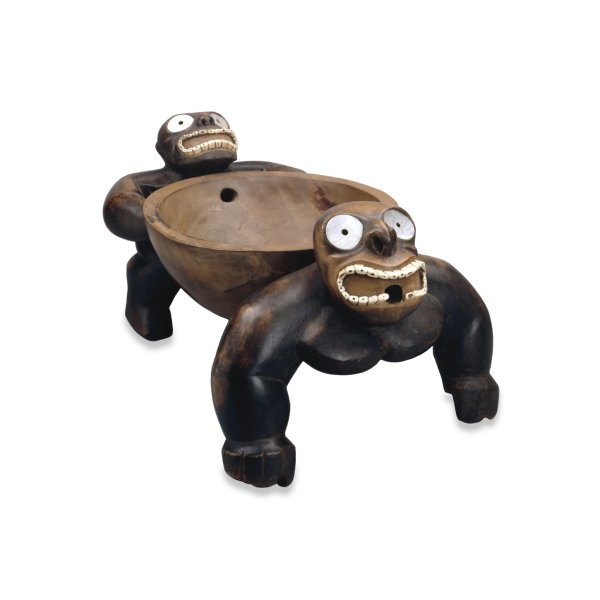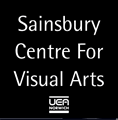Pacific Encounters - The Exhibition - Exhibition aims and audiences - Publications and educational activities-list of lenders

Bowl with two figure supports
Hawaiian Islands
Mid/Late 18th Century
Wood, pearl shell, boars' tusk
1.46.5cm
London, BM: HAW 46
Donated 1780 by Sir Joseph Banks; given to Captain Charles Clerke by a chief of
Kaua'i on 23 January 1778
A major outcome of the Polynesian Visual Arts project has been an exciting new exhibition at the Sainsbury Centre for Visual Arts, at the University of East Anglia which took place on Sunday 21 May to Sunday 13 August 2006.
A range of conferences and events related to this exhibition was organised.
Contents:
Publications and educational activities
Pacific Encounters: Art and Divinity in Polynesia 1760-1860
|
Pacific Encounters: Art and Divinity in Polynesia 1760-1860 Britain holds the most comprehensive 18th and 19th century Polynesian collections in the world, yet much of this material is little-known and seldom exhibited. In Pacific Encounters, important material from British and other collections was brought together in a major exhibition. Presenting 270 rare and visually stunning sculptures, ornaments, textiles and valuables, the exhibition explored Polynesia during a dynamic period in its history - the era of contact with European voyagers, missionaries and traders. Polynesians continue to have a vibrant living culture and this exhibition explored an important part of their history while extending appreciation of one of the world’s great but little-known art traditions. The exhibition was shown in both temporary exhibition spaces, and was also used to inaugurate the new link exhibition space in the refurbished Sainsbury Centre. The British Museum, from whom some 120 items were borrowed, was a major partner in the project.
Around 270 objects were displayed, including major sculptures in wood and stone, feather and basketry images, feather cloaks, wood bowls, decorated bark cloths, ornaments and valuables of ivory, shell, bone and nephrite, and other ritual items such as fly whisks, fans and drums. The objects were drawn from the major regions of Polynesia (Society Islands [Tahiti], Austral Islands, Cook Islands, Marquesas Islands, Hawaii, Easter Island, Tonga, Fiji, Samoa and New Zealand), and will be provenanced to the period 1760-1860.
The majority of the exhibition (c. 120 items) from the exceptional collections of the British Museum, which holds material from the voyages of Wallis, Cook, Vancouver and other explorers, as well as many rare objects deriving from the London Missionary Society. Complementary material from Oxford, Cambridge, Edinburgh, Newcastle, Exeter, Ipswich and other UK institutions was selected, together with material from elsewhere in Europe and the Pacific. For a complete list of all the lenders click here.
The exhibition was curated by Dr Steven Hooper, Director of the Sainsbury Research Unit for the Arts of Africa, Oceania and the Americas, University of East Anglia, on behalf of the Sainsbury Centre for Visual Arts and in collaboration with the British Museum. Polynesian institutions and scholars were involved and appropriate ritual procedures took place at the opening and closing of the exhibition.
A reduced and adapted version of the exhibition, exhibiting some 100 objects from the British Museum collections only, was shown in the British Museum from late September 2006 to early January 2007. A joint conference was held in early December.
Exhibition aims and audiences
The exhibition, its associated catalogue and programmes aimed to extend understanding and appreciation of the arts and cultures of Polynesia for the specialist and non-specialist alike, while also challenging clichés and stereotypes. The displays and texts went beyond ‘style-area’ information to explain the relationship between religion and the form, materials and style of artefacts in a dynamic historical context – the period covering significant European contact with Polynesian communities and their subsequent conversion to Christianity. Recent scholarship in the fields of anthropology, art history, history and archaeology permits a more sophisticated assessment of the nature of Polynesian societies, cosmologies, arts and material culture at that time, and also of the complex relationships between Polynesian and European ‘gods, chiefs and priests’. This scholarship, in concert with the highest standards of design and display, was used to present Polynesian material in a new light, accessible to a variety of audiences, from students to the layperson, the historian, the artist, the art historian and the anthropologist. More broadly, it was intended that the exhibition would contribute to wider understandings of the ways that divinity is instantiated in material form in a range of cultural traditions, including those of Europe.
Publications and educational activities
A fully illustrated 288-page catalogue has been published by the British Museum Press, including ten maps and three introductory essays placing the objects in their cultural and historical contexts. The final essay discusses the history of the collection of this material by explorers, missionaries and traders, and the routes by which it eventually came to museums. The essays have been illustrated with pictorial material taken from voyaging and missionary sources (paintings, engravings from Cook’s Voyages and missionary publications). The catalogue refined attributions of previously unprovenanced objects and incorporates the latest scholarship on Polynesia. Such objects have remarkable stories to tell of encounters between humans and their gods, between Polynesians and Europeans, their respective chiefs and priests, and beliefs and technologies.

|
